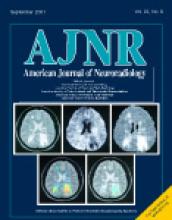Abstract
BACKGROUND AND PURPOSE: This study was undertaken to analyze enhancement patterns of the dura around sellar tumors and to compare the results with tumor invasion or compression of the cavernous sinuses. Postoperative enhancement patterns on MR images were compared with preoperative findings.
METHODS: Contrast-enhanced coronal and sagittal MR images were examined prospectively in 96 patients with sellar tumors (65 macroadenomas, 15 microadenomas, 14 Rathke cleft cysts, and two chordomas at the sella). All patients underwent surgical treatment, and pre- and postsurgical features on MR images were compared.
RESULTS: Presurgical MR images showed dural enhancement in 36.5% of the patients: asymmetric tentorial enhancement in 24 patients, symmetric tentorial enhancement in seven, and sphenoidal ridge or clivus enhancement in four. Asymmetric tentorial enhancement disappeared after surgical decompression in seven patients. For evaluation of cavernous sinus invasion ipsilateral to the enhancement, sensitivity and specificity of the asymmetric tentorial enhancement sign were 81.3% and 86.3%, respectively. Sensitivity and specificity of the sign were 42.9% and 93.6% for cavernous sinus involvement, including compression and invasion.
CONCLUSION: Asymmetric tentorial enhancement is a useful sign in the diagnosis of invasion or severe compression of the cavernous sinus by sellar tumor. The sign may represent venous congestion or collateral flow in the tentorium due to obstructed flow in the medial portion of the cavernous sinus.
- Copyright © American Society of Neuroradiology







